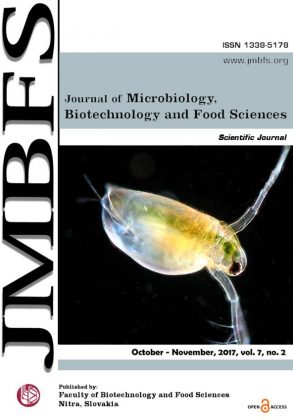QUALITY OF BOVINE PREIMPLANTATION EMBRYOS IN RELATION TO CATTLE BREED
DOI:
https://doi.org/10.15414/jmbfs.2017.7.2.143-144Keywords:
Cattle, breed, embryo, cell number, apoptosisAbstract
The aim of this study was to compare quality of bovine preimplantation embryos recovered from cows of three cattle breeds bred in Slovakia: Holstein (n= 38), Pinzgau (n= 28) and Slovak Pied (n= 53). Total number of embryo cells (DAPI-stained nuclei) and incidence of dead cells (TUNEL-positive nuclei) were counted in total of 563 bovine blastocysts collected from three breeds under the Leica fluorescent microscope. This study was done in 12 experiments performed during seven years. The lowest total number of embryo cells was counted in Pinzgau cattle (107 ± 8.5) and the highest – in Holstein cows (121 ± 5.5), whilst in Slovak Pied cows the embryo cell number was at moderate value (112 ± 6.4). The highest dead cell index (%) was calculated in embryos from Pinzgau cattle (6.22 ± 0.57), whilst Holstein and Slovak Pied embryos showed almost similar values (5.72 ± 0.34 and 5.31 ± 0.49, resp.). However, in both cases these differences among the breeds were statistically insignificant. In conclusion, present study did now reveal an influence of cattle breed on the quality of bovine preimplantation embryos. These findings may have an importance at the realization of genetic resource preservation program in Slovakia.Downloads
Download data is not yet available.
Downloads
Published
2017-10-01
How to Cite
V. Makarevich, A., KuboviÄova, E., & Chrenek, P. (2017). QUALITY OF BOVINE PREIMPLANTATION EMBRYOS IN RELATION TO CATTLE BREED. Journal of Microbiology, Biotechnology and Food Sciences, 7(2), 143–144. https://doi.org/10.15414/jmbfs.2017.7.2.143-144
Issue
Section
Biotechnology
License
Copyright (c) 2017 Alexander V. Makarevich, Elena KuboviÄova, Peter Chrenek

This work is licensed under a Creative Commons Attribution 4.0 International License.
All papers published in the Journal of Microbiology, Biotechnology and Food Sciences are published under a CC-BY licence (CC-BY 4.0). Published materials can be shared (copy and redistribute the material in any medium or format) and adapted (remix, transform, and build upon the material for any purpose, even commercially) with specifying the author(s).





